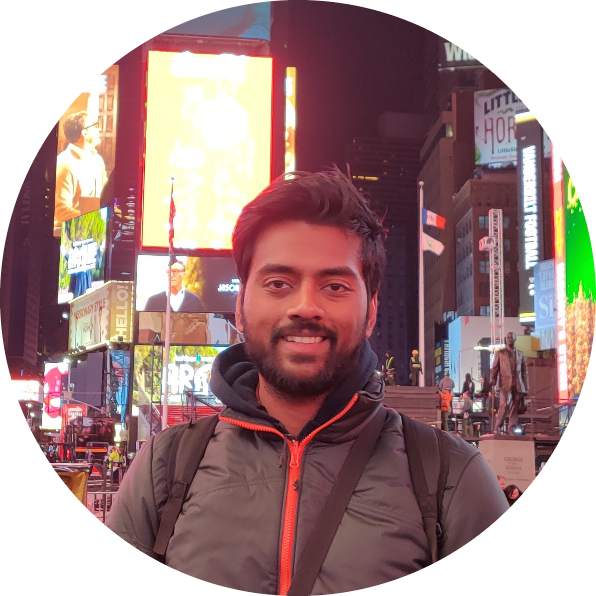
I am a first year EECS PhD student at MIT advised by professors Leslie Kaelbling and Tomas Lozano-Perez. I am part of the Learning and Intelligent Systems (LIS) Group, part of the broader CSAIL Embodied Intelligence (EI) Group. I am broadly interested in problems at the intersection of robotic perception and TAMP. Previously, I was a visiting researcher at REAL at Université de Montréal associated with Mila. I was advised by Prof. Liam Paull.
I completed my Masters by research from IIIT Hyderabad, and was advised by professors C V Jawahar and Vinay Namboodiri in the computer vision (CVIT) lab and by professors Madhava Krishna and Srinath Sridhar (Brown University) in the robotics (RRC) lab. My work spanned the broad areas of talking-face generation, video understanding and generation, and robotic perception & manipulation.
Apart from academia, I spent time as a Software Engineer at Microsoft India, and worked for Bing (People Also Ask feature) and Azure (Education and Healthcare initiatives) organizations. My work was covered in the press.
I completed my Bachelors from PES University (formerly PESIT) Bangalore in Computer Science. I worked in the areas of sound event detection and localization, and spent a considerable amount of time interning at The University of Calgary (through MITACS) with Prof. Mike Smith and Microsoft Research India.
Research Interests: My research interests lie broadly at the intersection of computer vision and robotics. My goal is to integrate representation learning with task & motion planning to achieving general-purpose robot autonomy.
Publications

|
ConceptGraphs: Open-Vocabulary 3D Scene Graphs for Perception and PlanningAditya Agarwal ,Paper / Project Page / Code (Coming Soon) / Video (Coming Soon) We propose ConceptGraphs, an open-vocabulary graph-structured representations for 3D scenes, built by leveraging 2D foundation models and fusing their output to 3D by multiview association. The resulting representations generalize to novel semantic classes, without the need to collect large 3D datasets or finetune models. The utility of this representation is demonstrated through downstream robotic planning tasks. |

|
EDMP: Ensemble-of-costs-guided Diffusion for Motion PlanningAditya Agarwal ,Paper / Project Page / Code (Coming Soon) / Video We propose EDMP for motion planning, that combines the strengths of classical motion planning (offering remarkable adaptability) and deep-learning-based motion planning (prior understanding over diverse valid trajectories). Our diffusion-based network is trained on a set of diverse kinematically valid trajectories. For any new scene at the time of inference, we compute scene-specific costs such as "collision cost" and guide the generation of valid trajectories that satisfy scene-specific constraints. |
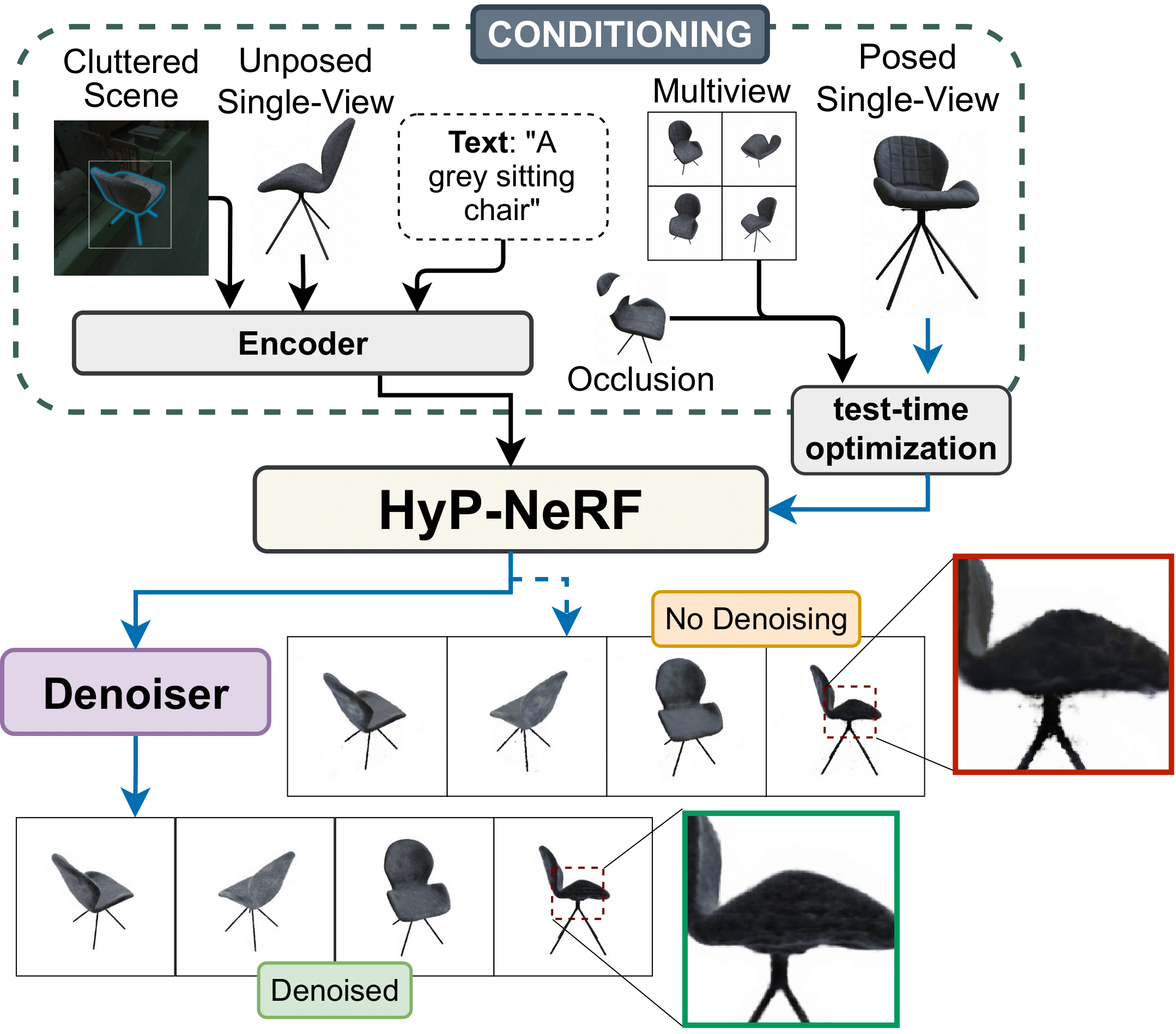
|
HyP-NeRF: Learning Improved NeRF Priors using a HyperNetworkAditya Agarwal* Paper / Code (Coming Soon) / Video We propose HyP-NeRF, a latent conditioning method for learning generalizable category-level NeRF priors using hypernetworks. We use hypernetworks to estimate both the weights and the multi-resolution hash encodings resulting in significant quality gains. To further improve quality, we incorporate a denoise and finetune strategy that denoises images rendered from NeRFs estimated by the hypernetwork and finetunes it while retaining multiview consistency. |

|
Disentangling Planning and Control for Non-prehensile Tabletop ManipulationAditya Agarwal Paper (Coming Soon)/ Video (Coming Soon) We propose a framework that disentangles planning and control for tabletop manipulation in unknown scenes using a pushing-by-striking method (without tactile feedback) by explicitly modeling the object dynamics. Our method consists of two components: an A* planner for path-planning and a low-level RL controller that models object dynamics. |

|
SCARP: 3D Shape Completion in ARbitrary Poses for Improved GraspingAditya Agarwal* Paper / Project Page / Short Video / Code / Poster / Long Video We propose a mechanism for completing partial 3D shapes in arbitrary poses by learning a disentangled feature representation of pose and shape. We rely on learning rotationally equivariant pose features and geometric shape features by training a multi-tasking objective. SCARP improves the shape completion performance by 45% and grasp proposals by 71.2% over existing baselines. |
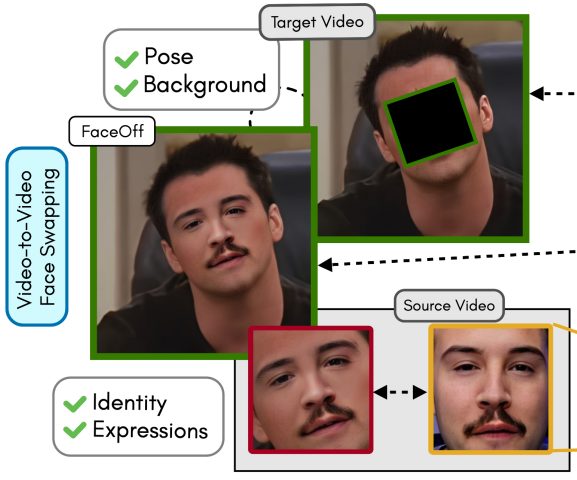
|
FaceOff: A Video-to-Video Face Swapping SystemAditya Agarwal* Paper / Project Page / Video / Poster / Code / Supplementary We propose a novel direction of video-to-video (V2V) face-swapping that tackles a pressing challenge in the moviemaking industry: swapping the actor's face and expressions on the face of their body double. Existing face-swapping methods preserve only the identity of the source face without swapping the expressions. In FaceOff, we swap the source's facial expressions along with the identity on the target's background and pose. |
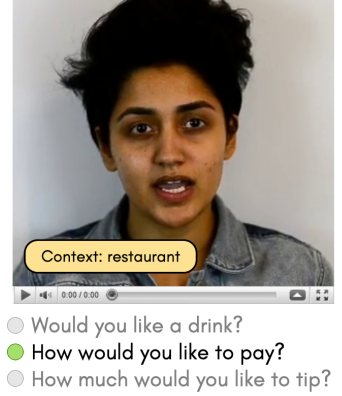
|
Towards MOOCs for Lipreading: Using Synthetic Talking Heads to Train Humans in Lipreading at ScaleAditya Agarwal* Paper / Project Page / Video / Poster / Supplementary Hard-of-hearing people rely on lipreading the mouth movements of the speaker to understand the spoken content. In this work, we developed computer vision techniques and built upon existing AI models, such as TTS and talking-face generation, to generate synthetic lipreading training content in any language. |

|
INR-V: A Continuous Representation Space for Video-based Generative TasksAditya Agarwal* Paper / OpenReview / Project Page / Video / Code Inspired by the recent works on parameterizing 3D shapes and scenes as Implicit Neural Representations (INRs), we encode videos as INRs. We train a hypernetwork to learn a prior over these INR functions and propose two techniques, i) Progressive Training and ii) Video-CLIP Regularization to stabilize hypernetwork training. INR-V shows remarkable performance on several video-generative tasks on many benchmark datasets. |
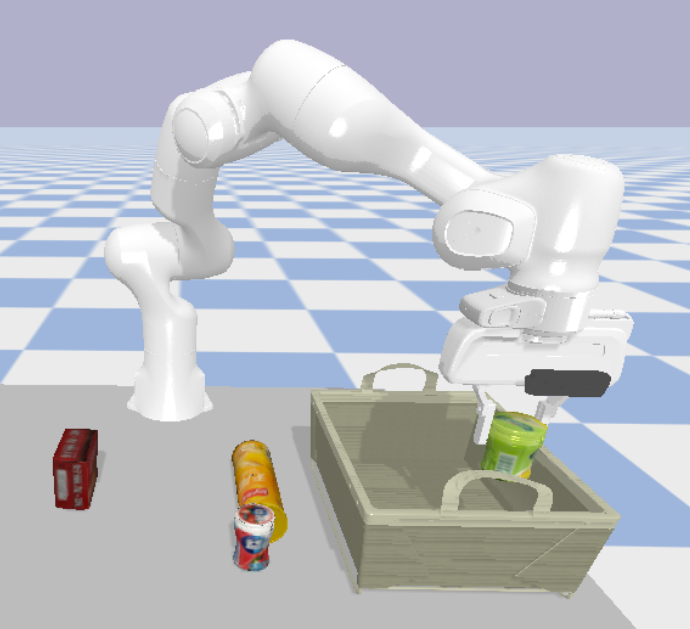
|
Approaches and Challenges in Robotic Perception for Table-top Rearrangement and PlanningAditya Agarwal* 3rd in ICRA 2022 Open Cloud Table Organization Challenge Paper / Competition / Video / Slides / Code / News1 / News2 In this challenge, we proposed an end-to-end pipeline in ROS incorporating the perception and planning stacks to manipulate objects from their initial configuration to a desired target configuration on a tabletop scene using a two-finger manipulator. The pipeline involves the following steps - (1) 3D scene registration, (2) Object pose estimation, (3) Grasp generation, (4) Task Planning, and (5) Motion Planning. |
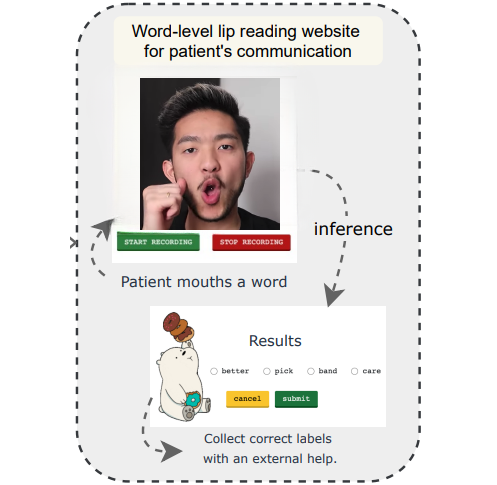
|
Personalized One-Shot Lipreading for an ALS PatientAditya Agarwal* We tackled the challenge of lipreading medical patients in a one-shot setting. There were two primary issues in training existing lipreading models - i) lipreading datasets had people suffering from no disabilities, ii) lipreading datasets lacked medical words. We devised a variational encoder-based domain adaptation technique to adapt models trained on large amounts of synthetic data to enable lipreading with one-shot real examples. |

|
REED: An Approach Towards Quickly Bootstrapping Multilingual Acoustic ModelsAditya Agarwal* We tackled the problem of building a multilingual acoustic model in a low-resource setting. We proposed a mechanism to bootstrap and validate the compatibility of multiple languages using CNNs operating directly on raw speech signals. Our method improves training and inference times by 4X and 7.4X, respectively, with comparable WERs against RNN-based baseline systems. |

|
An Approach Towards Action Recognition using Part Based Hierarchical FusionAditya Agarwal* The human body can be represented as an articulation of rigid and hinged joints, which can be combined to form the parts of the body. In this work, we think of human actions as a collective action of these parts. We propose a Hierarchical BiLSTM network to model the spatio-temporal dependencies of the motion by fusing the pose-based joint trajectories in a part-based hierarchical fashion. |

|
Minimally Supervised Sound Event Detection using a Neural NetworkAditya Agarwal We solve the task of polyphonic sound event detection by training on a minimally annotated dataset of single sounds. Single sounds represented as MFCC features are used to train a neural network. Polyphonic sounds are preprocessed using PCA and NMF, and source-separated sounds are inferred using the learned network. Our system achieves reasonable accuracy of source separation and detection with minimal data. |
News & Announcements
-
[Nov '23] Awarded NeurIPS 2023 Scholar Award (~$1700).
-
[Nov '23] Co-presented 2 papers at PRL, TGR, and LangRob workshops at CoRL2023 in Atlanta, Georgia.
-
[Sep '23] Hyp-NeRF accepted at NeurIPS 2023. See you in New Orleans, Louisiana.
-
[Sep '23] Joined Massachusetts Institute of Technology as a PhD student in EECS.
-
[Apr '23] I'll be joining MIT CSAIL as a PhD student this Fall. I will be a part of the Learning and Intelligent Systems (LIS) Group with professors Leslie Pack Kaelbling and Tomas Lozano-Perez.
-
[Apr '23] Full page abstract on "Uncovering Biases Against Indian Artists" accepted at ICMPC17-APSCOM7 for a spoken presentation. Awarded a Travel Grant of ¥30,000 to attend the conference in Tokyo, Japan.
-
[Mar '23] Awarded a generous travel grant of $2250.00 by ICRA 2023 IEEE RAS Travel Grant Committee to attend the premier robotics conference in London, UK from 29th May to 2nd Jun.
-
[Mar '23] Invited for a talk at Columbia University - slide deck here. The talk was organized as part of my graduate visit days to Brown, Columbia, and MIT.
-
[Jan '23] 5 works on Implicit Video Parameterization, V2V Face-Swapping, MOOCs for Lipreading, 3D Shape Completion, and Synergistic Tabletop Manipulation presented at IIIT Hyderabad's RnD showcase.
-
[Jan '23] 1 paper accepted at ICRA 2023 on 3D Shape Completion in Arbitrary Poses. Featured as the "Publication of the Week" in "Weekly Robotics".
-
[Jan '23] Attending Google Reserach Week in Bangalore from 29th Jan to 31st Jan.
-
[Oct '22] Journal paper on representation space for video-based generative tasks accepted at TMLR 2022.
-
[Aug '22] Two papers on video face swapping and talking-face generation accepted at WACV 2023 round 1 (acceptance rate 21.6%).
-
[May '22] We were in the News (news1, news2) for winning 3rd place at the ICRA 2022 international robotics competition on tabletop rearrangement and planning. Awarded a grant of $1000.00.
[Oct '21] 1 paper accepted at BMVC on lipreading in a one-shot setting using domain adaptation.
-
[Mar '21] I will be joining IIIT Hyderabad as an MS by Research student.
-
[Nov '20] 1 paper accepted at SLT on building multilingual acoustic model for low-resource languages.
-
[Sep '17] Completed my Bachelor's degree from PES University in Computer Science. Received Academic Distinction Award for exceptional academic performance.
-
[Jan '16] I will be interning at the University of Calgary in Summer 2016 fully-funded through the MITACS Globalink Research Award.
[May '23] I'll be starting as a research intern at Mila - Quebec Artificial Intelligence Institute, Montreal with professors Liam Paull and Florian Shkurti. I will work on learning representations for 3D robotic manipulation.
Academic Services
-
Reviewer for SIGGRAPH 2023, IROS 2023, ICLR 2023 workshops, ICRA 2023.
-
[Aug '22] Coordinator for the 6th CVIT Summer School on AI.
-
[Aug '22] Gave a talk on the challenges in tabletop rearrangement and planning at CVIT Summer School 2022.
-
[Feb '22] I will be taking month long tutorial sessions in machine learning for faculties across universities in India as part of the CSEDU-ML program conducted jointly by IIIT-H, IIT-H, and IIT-D.
-
[Aug '21] Coordinator for the 5th CVIT Summer School on AI and conducted tutorial sessions on self-supervised learning and multimodal learning.
Professional Achievements
-
[Aug '17] Winners at the VMWare Global Relay Opensource Borathon among all participating teams at VMWare.
-
[Mar '20] I was selected as one of the two individuals out of 6,000 employees at Microsoft India to undergo a video shoot for the company's campus hiring program. Available on YouTube.
-
[Mar '18] My work helped scale the Microsoft Community Training platform to its first 100K users. The work was covered by several media outlets ([1], [2], [3], [4]). I was awarded the "Delight your Customer" Award by Microsoft for my outstanding work.
-
[Feb '17] My work on building Microsoft Research India's flagship project Massively Empowered Classroom was deployed by Mauritius Institute of Education. It was inaugurated by MD MSR India and Minister of Tertiary Education, Mauritius and was covered by the press ([1], [2], [3]).
Forked and modified from Viraj Prabhu's adaptation of Pixyll theme






